On doing as much as you can for as long as you can
Prelude
Vivian Tumelson is an 87-year-old quilt maker who lives in Blanchard, Oklahoma. She’s been making quilts her whole life, but since retiring in 1989, making quilts has become something of a full-time job.
Conversation
On doing as much as you can for as long as you can
Quilter Vivian Tumelson on continuing a tradition that was handed down from her mother, how a post-retirement hobby turned into a full-time job, and why staying busy is the key to staying happy and healthy as you age.
As told to T. Cole Rachel, 2742 words.
Tags: Craft, Art, Inspiration, Process, Beginnings, Independence, Money.
When did you first learn how to make quilts?
Well, my mom made quilts before I was even born and up until she died. She went blind eventually, but she quilted until she went blind, and I just kind of learned from her. And then years later my sister went to the fair and they had this big quilting machine on display. She was so impressed with it. She came home and she said, “I want you to find me one of these quilting machines.”
So I called Singer—the sewing machine company—and they said they didn’t stock them in stores, because they were so expensive to inventory, but they said, “We can get you one in a week if you want it.” So I asked my sister and she said yes, she wanted it. So it came all the way from Grove, Oklahoma. Turns out, the guy up there actually invented the quilting machine.
He was already an elderly guy at the time, but he still had a shop up there in Grove. And my sister had an empty house. They had bought another house, and they had moved, but they still had their old house with the electricity and everything still hooked up. So they took the quilting machine over there and set it up. Then she called me and said, “Well, I didn’t get this for me. I got it for you. You’re the quilter.”
I had just retired, so I had time, but I didn’t know how to run an electric quilting machine. One of my neighbors told me they knew a woman who had one, so I got her number and called her up and she invited me to come over. She had the same kind of machine. My niece and I went over to visit her and she put us to work making baby quilts and we ended up making them all day long. Turns out, there wasn’t much to it. I just kept working at it.
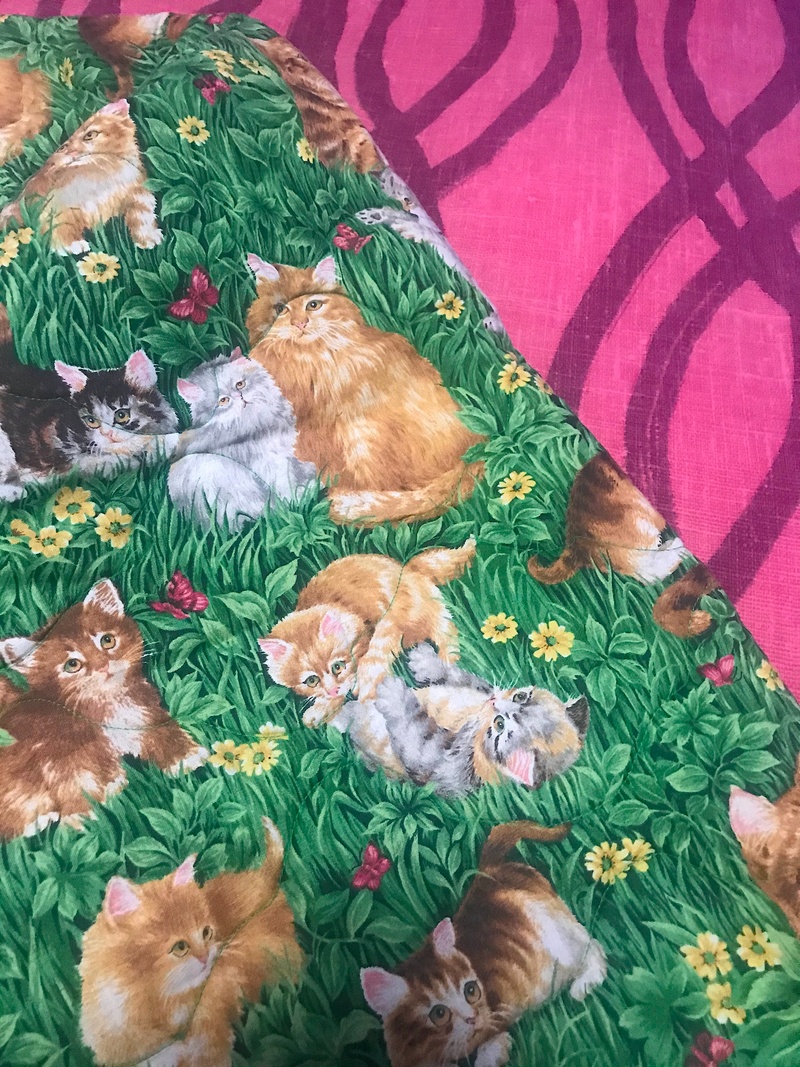
My Grandma Rachel was a quilter, too. She mostly made the blocked quilts that are—what do you call it, tacked? They are tied and tacked in certain spots with yarn.
Yes, that’s just called tacking. That’s a pretty popular kind of quilt. My mother taught me to do the actual quilting, just like what I do now, except she didn’t have machines. She did it all by hand. Her stitches were all handmade, and it took her probably three weeks to make a quilt, to quilt it after she got the top made. She put the blocks together, also, but to do the actual quilting, you have to have that already done. And then the quilt itself has a top—usually the quilt blocks that have been put together—a bottom, which is usually a solid fabric, and then you have some kind of batting that you put in between. The actual quilting is the stitches that you make that hold the the whole thing together. The quilt blocks on top make one kind of pattern, then your quilt stitches make another kind of pattern.
My mother didn’t have a machine, of course, but back in those days you used what they called quilt frames, which hung from the ceiling, and let you roll the quilt down from the ceiling as you worked on it. At night you’d just roll it all back up. And in the corners, where the frames went together, it had big long nails that were about eight inches long, and my dad was a tall man, and he would bump his head on those nails. He would get so upset with her!
How long ago was it that you retired?
In 1989. But, I’ve always made quilts. Back then I’d put the pieces together, but I would always have somebody else actually quilt them for me.
Part of what I love so much about the old quits I have is that they’re made out of so many different kinds of things. Quilts are the original form of household recycling. Anything could get turned into a quilt.
Yeah, my mother never threw anything away. She made all of our clothes and she would save all that was left after she got the clothes made, and she would make quilts out of the scraps. She had this one quilt that she called a string quilt—there was nothing in it that was more than two inches wide. It was just all those little tiny pieces put together.
She also belonged to this quilting club. I think it was on Mondays. All the ladies who lived close by would get together at the church and make quilts. When I was little, I would go with her and watch her make quilts with all those other ladies. And none of them quilted the same. My mother made the tiniest little stitches you ever saw. You almost can’t make that small a stitch even with a machine. It was just so tiny. But some of the women made really big, messy stitches, but they would all end up working on the same quilt. Quilting, especially in small little towns like the one I come from, was a social thing. The women all got to visit while they worked.
I went to a craft show at Turner Falls one time, and I had my quilts hanging on a rack. And this lady kept looking and looking and looking at my quilts. I said, “Are you checking my handiwork?” And she said, “Well, I’m checking your stitches, because I don’t want to have a quilt that I would hang my toenails in.” I thought that was so funny. But some of those ladies that my mother quilted with, their stitches, you could hang your toenails in them.
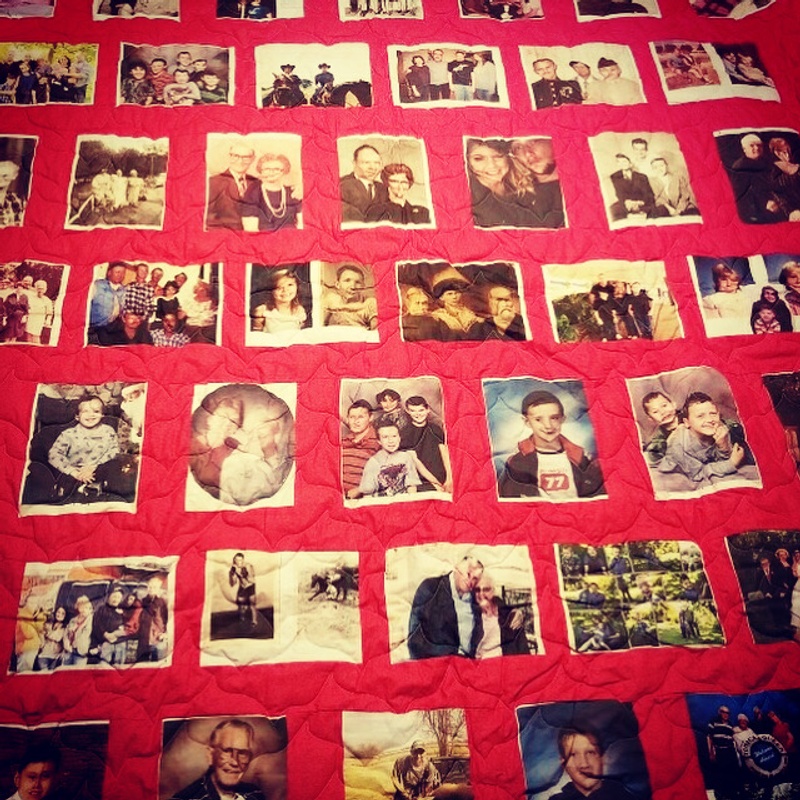
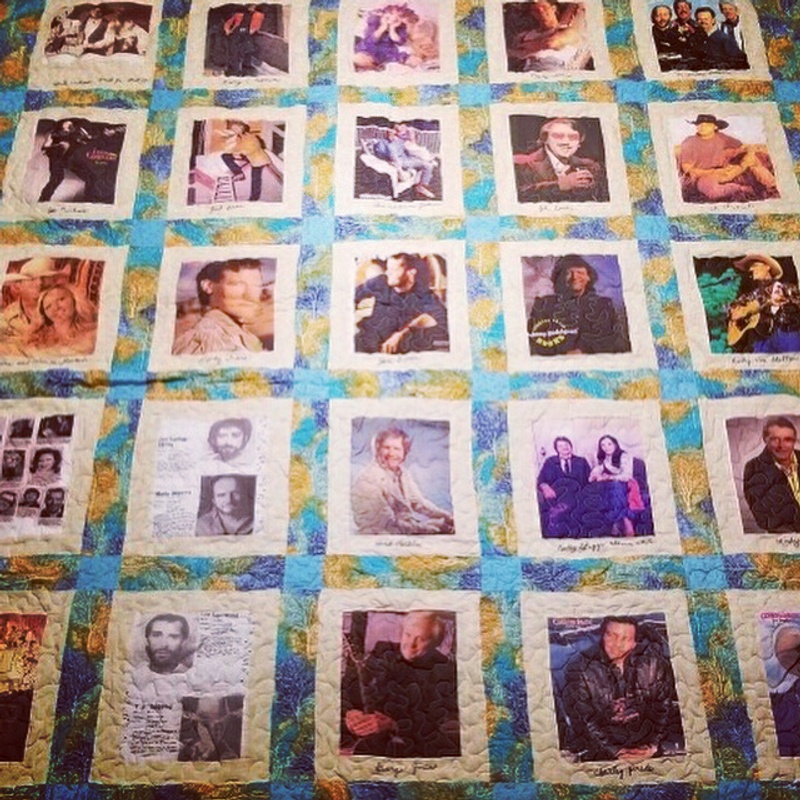
Quilting is now thought of as this very important American art form. Quilts are shown in museums and celebrated as an important kind of folk art. Would you ever think of it in that way?
Well, when I first started, I thought quilting was out. Nobody did it anymore. But when I started going to these craft shows, everybody asked me if I could make something for them. Maybe they had an old quilt top that they’d been saving but they just needed someone to quilt it for them, or maybe they just wanted something made by hand. I learned that there were actually a lot of people still making quilts, we just didn’t see it. And suddenly I just got so busy quilting, I couldn’t keep up.
After you retired, did you anticipate that your quilting hobby would take on such a life of its own?
I didn’t intend for it to become another job, but that’s kind of how it’s turned out. Still, it relaxes me to do it. So if I get really stressed, I just go in the garage and start quilting… and I feel relaxed.
You have a really good setup for how you do it. You have a little quilt factory basically, with the machines set up and all your fabric lined up on the walls. It’s impressive.
Well, you just learn a little bit more as you go along. I ran into a lady over at Newcastle one day, and she said she had a machine that would put the binding around the edge of the quilt for you. I have arthritis in my thumb, so I couldn’t do that hand-binding like I always did before. She told me it was a commercial machine with this little attachment you could add that would sew on your binding for you. I couldn’t find one, so I called up an old friend of mine who had retired from the upholstery business. She had six of those commercial machines. I asked her if she wanted to sell me one of them, and she said she’d just give me one for free if I’d come and get it out of her garage. So I got one of them and I tracked down one of the attachments for it and now I can bind the edges of a quilt in about 10 minutes, where it used to take me three or four hours to do that by hand.
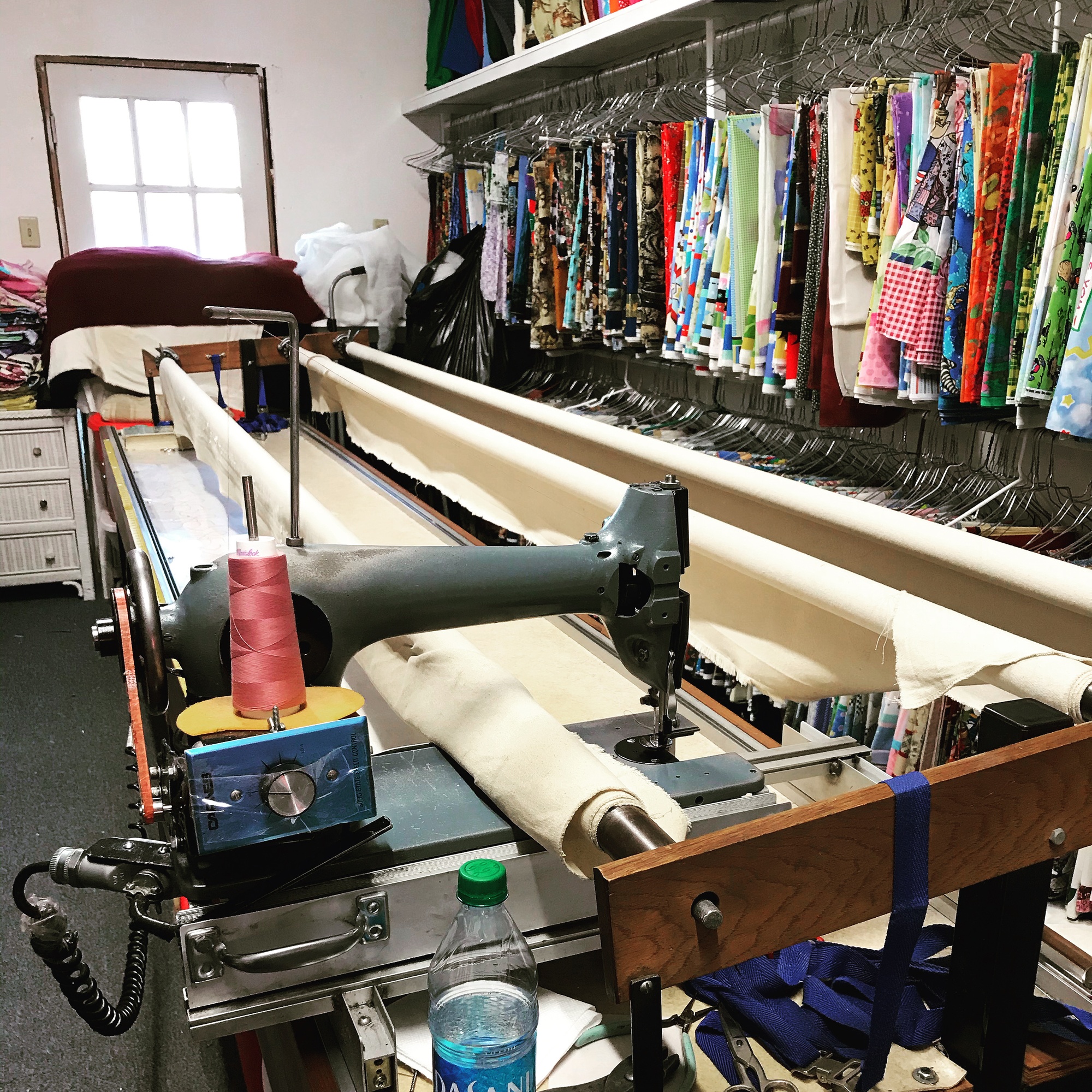
Vivian’s quilting studio
So you have this big quilting machine in your garage—what do you do if it breaks down?
There is a man who just lives down the road from me, and he’s a machine repairman. He fixes it all the time. They’re not like a regular sewing machine, the quilting machines. It takes a special person to work on them.
I know you’re quilting all the time, and you do craft shows, but how do most people find you?
I have cards printed up with my phone number on them. When I go to a craft show, I give them out. And then they usually tell somebody else. That’s all it takes. People find me. Right now I have one lady in Kansas that sends her quilts down here, and I have one in Tucson, Arizona, that sends her quilts. And a couple who used to live around here and moved away, they still send me their quilts.
Have you taught other people how to quilt?
Yes, lots of people. In fact, two or three other women have bought quilting machines after they’ve learned from me how to quilt. Like I say, there’s not a whole lot to learn about it. I buy my fabric mostly in bulk from a place called Marshall Dry Goods which is in Batesville, Arkansas. They have the best prices. Otherwise, you just learn as you go. It’s always been a skill that gets passed along from one generation to the next.
You make quilts to sell at craft shows, but do people ever just come to your house to look through your fabrics and design their own quilt?
Yes, they do, especially with baby quilts. I keep baby quilts made up all the time. If people have a baby shower or something, they’ll just come over and look to see what they want. The quilt will be unique, one of a kind. A lot of times at baby showers everybody gets the same thing. When they buy a handmade baby quilt, it’s unique. Nobody else has a baby quilt like it. As for the big quilts, I don’t normally keep them here to sell. If a close friend or a relative wants one that I have, I usually just give it to them. I don’t sell it. I wouldn’t know how to sell a big quilt. When I get through with them, if somebody wants them, I just give them away.
Is quilting a pretty major supplement to your income?
It is. It’s my play money. My retirement from working 28 years at AT&T, my social security, that’s my bill-paying money. Quilting is my play money.
You just celebrated your 87th birthday. Do you find that always having something to do and staying so busy is what has helped you to stay healthy?
Yes. I think that is absolutely true. It’s exercise. The quilting machine is huge—it fills up a room. So you are walking up and down, 12-feet each way, just up and down, up and down. That’s a lot of exercise, and I think it’s kept me healthy. I really do. And I’ve been doing it for 30 years now.
For someone who wants to learn how to quilt—but who isn’t probably going to buy a big quilting machine—how would you suggest they get started? Just by making something small?
Well, if you have a regular sewing machine, you can still do baby quilts. You can also sew things by hand. Just start small and practice. But if you want to do it on a big scale, you’ve got to have plenty of room, because the machine is 12-feet long, and then you need to have at least two-feet on each end and about three or four-feet on each side so you can move around it. There’s just not a lot of people that have that much excess room.
You’ve made quilts that have gone off to all sorts of interesting places. You have quilts that live in Nashville at the Country Music Hall of Fame, for example. You’ve made quilts as gifts for country music stars…
Yes, and I’ve made them for the American Legion. I made one for Governor Stitt. He has it in the Governor’s Office in Oklahoma City. When I was still working, I gave away over 200 quilts for the Telephone Pioneers, a charity, and they sold chances on them for a raffle. The money that the quilts brought went to relief work for people in wheelchairs, it was used to help build ramps for their houses for free. They never charged anybody for the material, or for the labor. One day the guy over at the Pioneers said to me, “I have tried to figure out how many quilts you’ve donated and the best I can figure out, it must be over 200 of them.” He was just figuring once a month for so many years. You know? I took one every month. There were usually at least 50 people who went to those luncheons, and all of them bought chances. So you can imagine how much money that brought in to the Pioneers, into their treasury. I feel good about that. Still, I just do this because I love doing it.
You also make quilts with photos on them sometimes.
Yes, they sell this white fabric in 8 x 10 sheets, and you can just print anything onto those white sheets and put it together and make a quilt. I’ve made one of our family, using family pictures, and I’ve done those for a few people. It’s nice to sleep under something that someone made my hand, I think. Especially if it has the faces of people who you love on it.
Do people ever hit you up with weird things that they want you to turn into a quilt?
Yes, T-shirts especially. And I had one lady who kept all of her daughter’s T-shirts from the time she was little up until she went away to college. She never threw them away. When the girl graduated high school, the lady called me and said, “Would you make me a quilt out of my daughter’s tee-shirts?” I said, “Well, it’s kind of going to be a chore.” Because there’s so many different sizes from a kindergarten person up to a high school person. I had to figure out how to make the little ones bigger—that was the hardest part. And then there’s a fabric that’s called Wonder-Under. You iron it on the back of something that’s stretchy, and it keeps it from stretching. And you know how T-shirts are, they’re really stretchy. So I would have to go get Wonder-Under, and iron it onto all the blocks after I got them cut out.
Yeah, that sounds pretty laborious.
I’ve probably done 20 of those T-shirt quilts, and that’s my least favorite thing to do, so don’t ask me to make you one! [laughs]
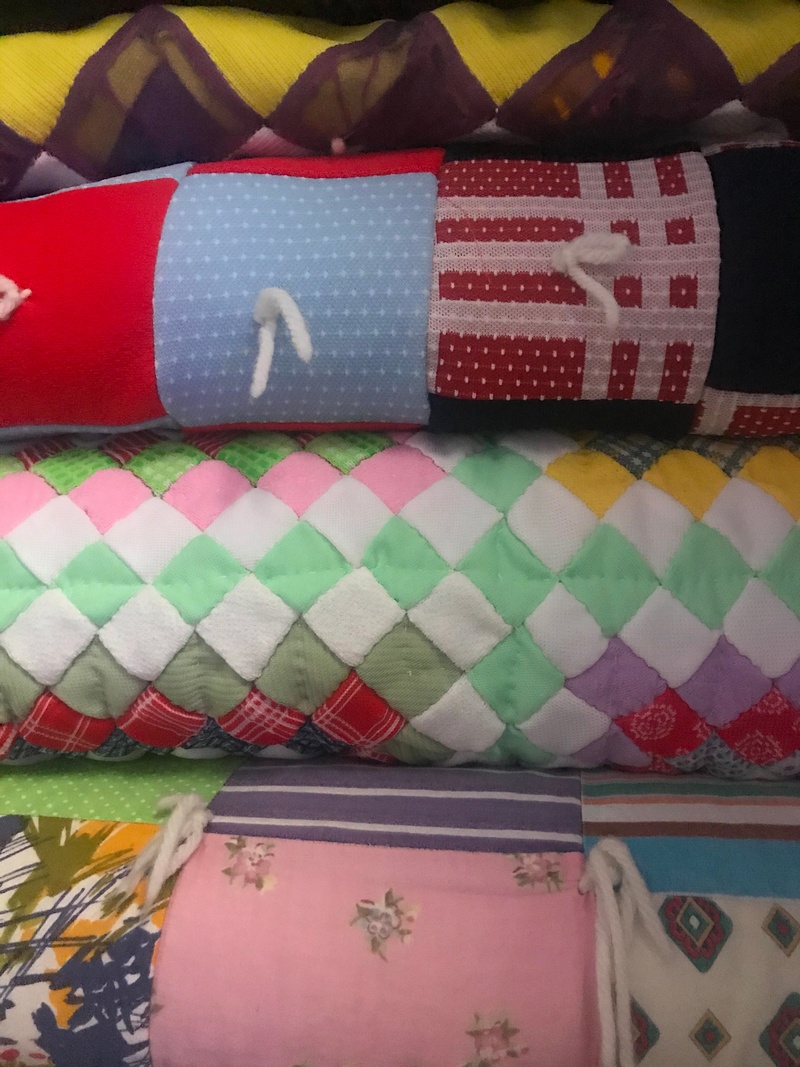
Vivian Tumelson Recommends:
Erle Stanley Gardner’s Perry Mason novels. He’s my favorite. I read a lot, but I don’t have time to read as much as I’d like.
I like to make candy, but I mostly just do that now on Christmas and Thanksgiving. I don’t do it all the time. But I love making peanut brittle, and that’s a job in itself. When you get ready to make it, you have to let everything else go and focus only on making that. And it has to be a sunny day, with no humidity. You can’t make peanut brittle if it’s humid, because it stays sticky. It won’t get brittle, which is the whole point.
I would recommend anybody staying busy—as much as they can for as long as they can. It keeps you healthy.
- Name
- Vivian Tumelson
- Vocation
- Quilter
Some Things
Pagination



